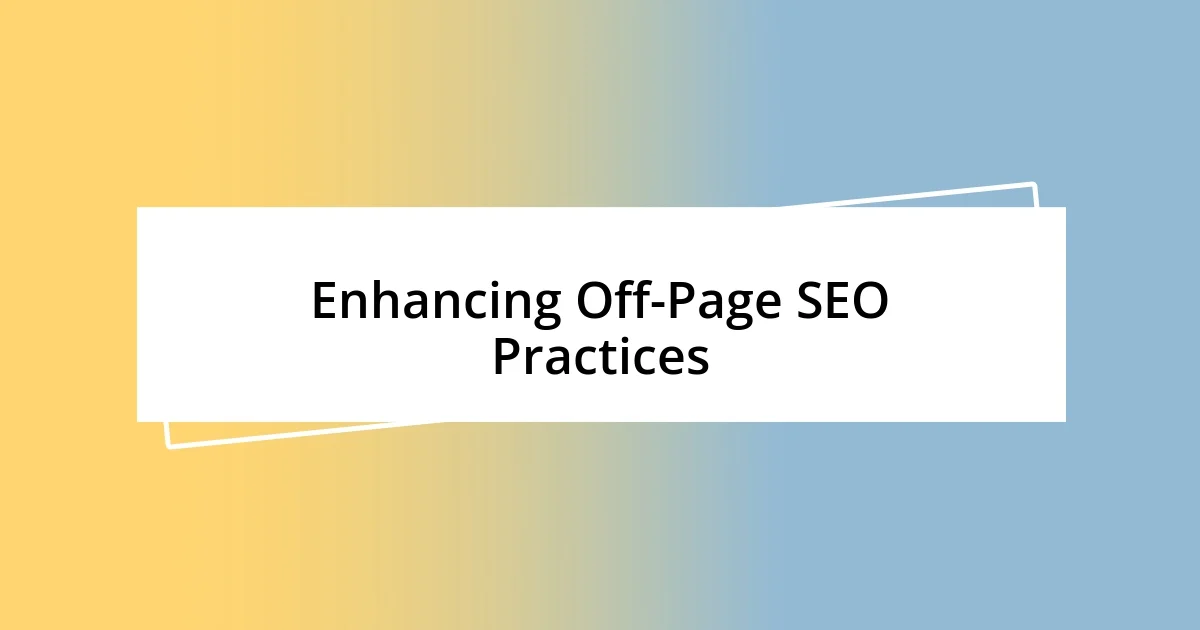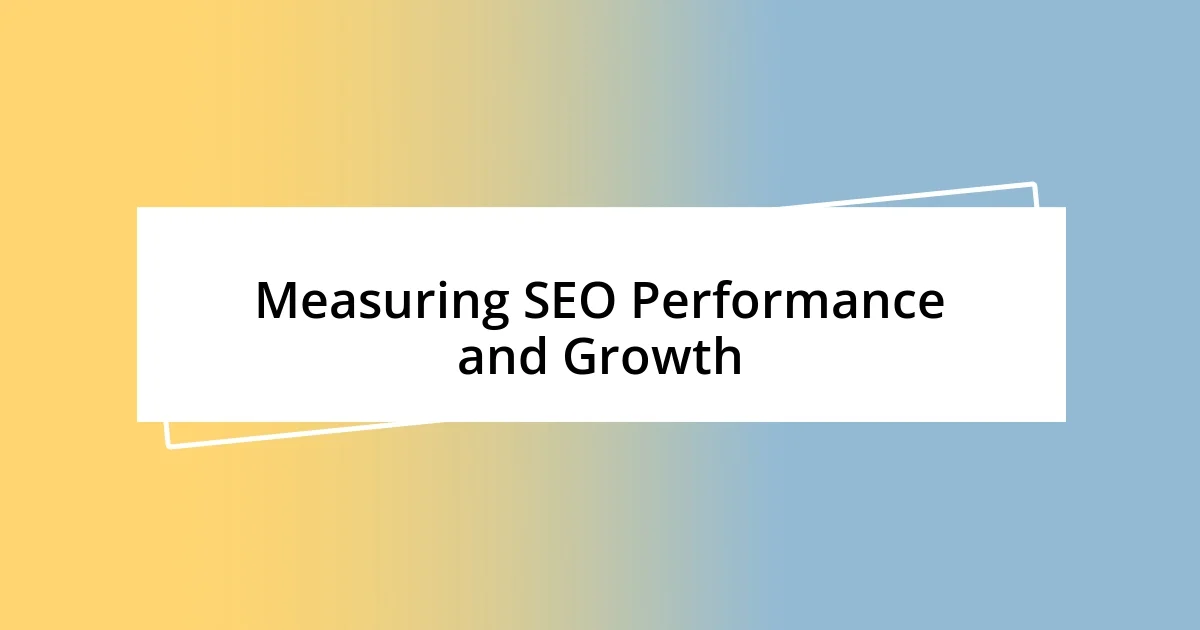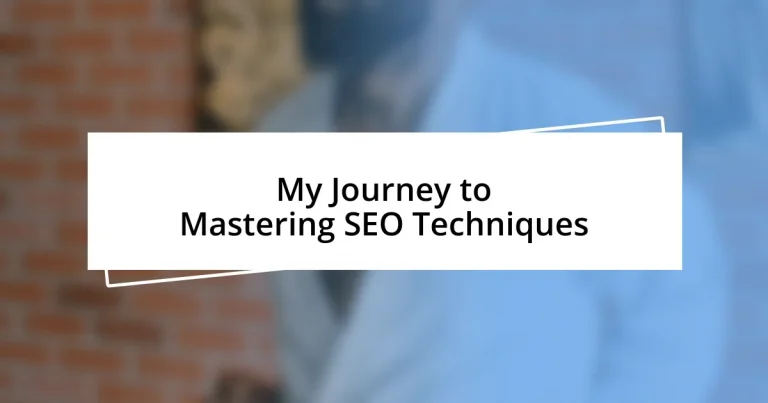Key takeaways:
- Mastering SEO is a continuous learning process that involves adapting strategies based on performance data and user intent.
- Utilizing essential tools like Google Analytics, SEMrush, and Ahrefs is crucial for tracking performance, keyword research, and improving SEO tactics.
- Building relationships through outreach and collaboration enhances off-page SEO efforts and drives engagement and traffic to your site.

Introduction to SEO Mastery
Mastering SEO is more than just understanding algorithms; it’s about connecting with your audience and delivering meaningful content. I still remember the first time I learned about keyword optimization—I was so excited to discover how simple tweaks could boost my website’s visibility. Have you ever felt that rush of seeing your hard work pay off in the form of increased traffic?
As I delved deeper into SEO techniques, I realized that it’s a constantly evolving art. It can be overwhelming at times, but that’s what makes it thrilling. It’s like piecing together a puzzle where each piece—be it link building, on-page optimization, or content strategy—plays a pivotal role in the bigger picture.
Reflecting on my journey, I see SEO mastery as an ongoing learning experience. There were moments of confusion and frustration, like when my website traffic dipped unexpectedly. I learned to embrace those challenges, understanding that every setback was an opportunity for growth. What about you? Have you faced a similar challenge on your own journey?

Understanding SEO Fundamentals
Understanding the fundamentals of SEO is crucial for anyone looking to make a mark online. I still vividly recall my early days of fumbling through SEO basics, feeling like I was trying to decipher a secret language. It may sound simple, but grasping the fundamental concepts can set the groundwork for more advanced strategies. Here are some essential elements you’ll want to keep in mind:
- Keywords: These are the terms and phrases people search for. Researching and appropriately using them is essential to attract the right audience.
- On-Page SEO: This involves optimizing individual pages on your website by using keywords, adjusting metadata, and ensuring readability.
- Link Building: Establishing outbound and inbound links helps improve your site’s authority and visibility.
- User Experience (UX): Ensuring your website is easy to navigate and loads quickly can greatly impact your SEO success.
- Search Engine Algorithms: Understanding how search engines rank pages can help you tailor your content accordingly.
As I navigated the intricacies of SEO, I realized the importance of consistently refining my strategies. I remember the moment I made a shift in my approach to content creation, focusing more on user intent rather than just stuffing keywords. This small change led to noticeable improvements in engagement. It was a reminder that SEO isn’t just about the technical aspects; it’s about the users, too!

Essential Tools for SEO Success
When I first started with SEO, I quickly realized that having the right tools can make all the difference. There are countless options available, but a few tools stood out for their functionalities and ease of use. For instance, Google Analytics and Google Search Console became my go-to resources for tracking website performance. They provided me with invaluable data on user behavior and site visibility, which helped me make informed decisions. Have you ever tracked changes in your website’s performance? It can be quite exciting to see what works and what needs tweaking.
Another tool that greatly enhanced my SEO strategy was SEMrush. The ability to conduct in-depth keyword research and competitive analysis was transformative. I remember using it for the first time and feeling overwhelmed by the sheer amount of data it provided. However, once I learned how to interpret this information, I gained a clearer understanding of my niche and audience. Would you agree that having an edge over competitors is crucial in SEO? SEMrush provided me that edge.
Apart from those, there are great tools like Ahrefs and Moz, which can help with link building and site audits. I often found myself relying on their comprehensive backlink analysis features, especially when I was trying to establish my website’s authority. The insights I gained through these tools shaped my approach in ways I hadn’t anticipated. It’s all about finding the right mix of tools that suit your specific needs and goals.
| Tool | Purpose |
|---|---|
| Google Analytics | Tracks user behavior and website performance |
| Google Search Console | Monitors site visibility and search performance |
| SEMrush | Keyword research and competitive analysis |
| Ahrefs | Backlink analysis and site audits |
| Moz | SEO insights and authority metrics |

Developing a Strategic SEO Plan
Developing a strategic SEO plan feels like crafting a roadmap for success; it requires both foresight and flexibility. I remember the first time I tried to outline my strategy, staring at a blank page unsure of where to start. Then, I broke it down into manageable sections, including keyword research, content creation, and tracking performance. By approaching it step by step, I finally found my direction.
As I delved deeper into the planning process, I realized that flexibility is key. Each time I conducted a performance review, the data often revealed surprises. For instance, a blog post I thought would flop ended up driving significant traffic. These unexpected insights reinforced my belief that a strategic plan isn’t static; it’s a living document that needs regular updates based on what the data tells you. Do you often revisit your strategy to adjust to new findings? Embracing this dynamic approach has allowed me to adapt swiftly to ever-changing trends.
One of the most enlightening moments in my SEO journey involved understanding the importance of aligning my goals with my audience’s needs. I vividly recall creating an in-depth guide on a specific topic, thinking it would engage readers. However, the real spark happened when I listened to feedback and tweaked my approach, prioritizing user intent over my initial assumptions. This taught me that developing a strategic SEO plan isn’t just about algorithms; it’s fundamentally about understanding people and their behaviors. Have you considered how your audience influences your strategy? At its core, SEO is about their experience, and that realization has shaped my path.

Implementing On-Page SEO Techniques
Implementing on-page SEO techniques is where my journey truly began to take shape. I recall setting my first meta description for a blog post; it felt like preparing a captivating invite for a party. Crafting the right words to entice clicks while incorporating my target keywords was a delicate balance, but I learned quickly that a well-optimized meta description can significantly improve click-through rates. Have you tried experimenting with different descriptions? It’s fascinating to see how small changes can lead to big results.
Another breakthrough moment for me was optimizing my headings and subheadings. Initially, I tended to underestimate their importance, but then I realized they not only help search engines understand the content hierarchy but also improve readability for my audience. I learned to incorporate relevant keywords naturally in my H1 and H2 tags. This subtle yet impactful change helped me see a noticeable difference in organic traffic. How often do we overlook the foundational elements of our content?
I also embraced the power of internal linking, which became a game changer for my site structure. By linking related posts, I provided readers with clear pathways to explore more content. I remember the sense of accomplishment when I saw the average session duration increase—proof that my audience was engaging more. Integrating this technique not only enhanced user experience but also strengthened my site’s SEO. Isn’t it amazing how thoughtful navigation can keep readers around longer?

Enhancing Off-Page SEO Practices
One of the most rewarding aspects of enhancing my off-page SEO practices has been the art of building relationships through outreach. I remember my first outreach email vividly; I was nervous but excited, reaching out to industry influencers to discuss potential collaborations. The sense of connection I felt when one of them actually responded was exhilarating. This interaction not only led to backlinks but also opened doors to guest blogging opportunities. Have you ever felt that thrill of making a meaningful connection in your professional journey?
Engaging with other communities through social media has also become a vital part of my off-page strategy. I recall joining niche-specific forums and sharing insights on topics I was passionate about. One day, a user reached out to me, expressing how a particular post resonated with them. That moment made me realize the power of authentic engagement; it’s not just about links but about building trust and authority in your niche. How often do we think of social platforms merely as promotional tools rather than spaces for genuine interaction?
Finally, I found that leveraging content marketing through influencer collaboration can significantly enhance off-page SEO. For instance, I once partnered with an influencer for a blog series, and the engagement we received was astounding. Their audience was eager to explore my insights, leading to a surge in traffic to my site. It made me appreciate the symbiotic relationship between sharing value and creating backlinks. Have you considered how collaboration might elevate your off-page strategies? That’s the beauty of SEO; it thrives on connection and collaboration.

Measuring SEO Performance and Growth
Measuring SEO performance and growth is where I truly started to see the fruits of my labor. I remember the anticipation of checking Google Analytics for the first time after implementing my strategies. Seeing an upward trend in organic traffic felt like unwrapping a gift; the effort I’d invested was finally paying off. Have you ever felt that rush of seeing numbers move in the right direction?
I quickly learned that tracking keyword rankings was equally critical. By using tools like SEMrush, I could pinpoint which keywords were driving traffic and which ones needed more attention. I recall diving deep into a keyword analysis report, feeling both overwhelmed and invigorated by the possibilities. These insights helped me refine my content strategy, aiming for terms that not only brought visitors but also converted them into loyal readers. Isn’t it enlightening how data can reveal opportunities you hadn’t considered?
Moreover, I started paying close attention to user engagement metrics such as bounce rates and average session duration. I recall a particular blog post that performed well initially, but as I examined the data, I noticed a high bounce rate. It was a wake-up call for me, nudging me to improve the content’s relevance and depth. After making adjustments, watching the bounce rate drop and session duration rise gave me an immense sense of accomplishment. Have you experienced those “aha” moments when data drives you to make meaningful changes? It’s in these moments that I truly recognized the evolving nature of SEO and my role in adapting to it.














